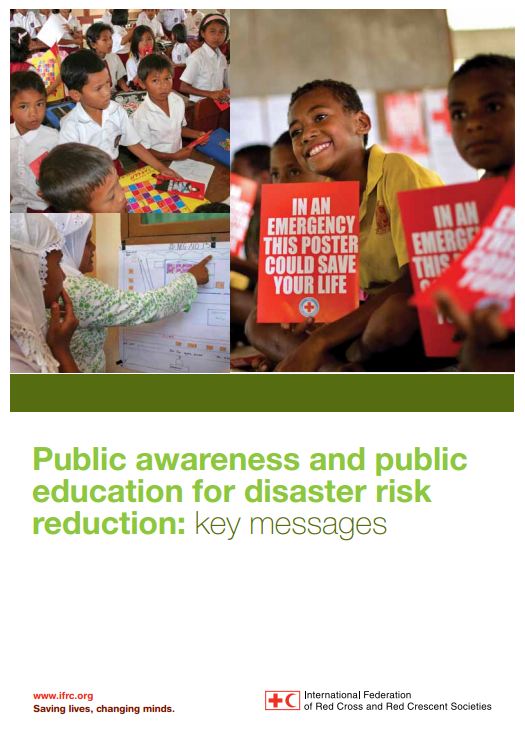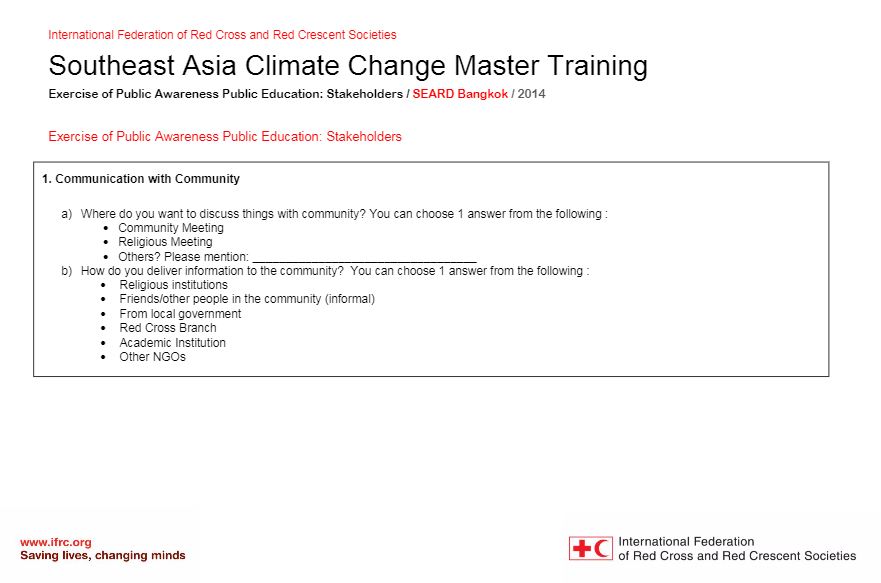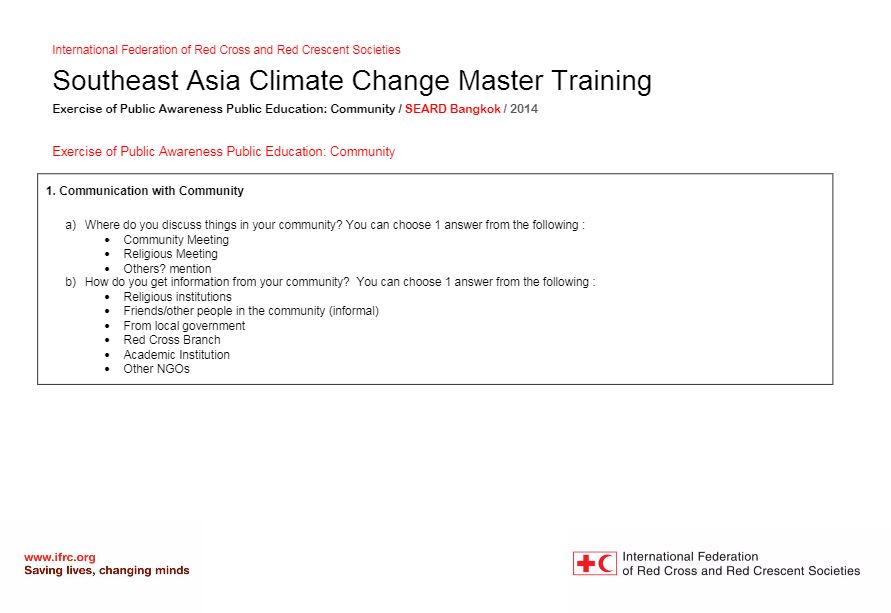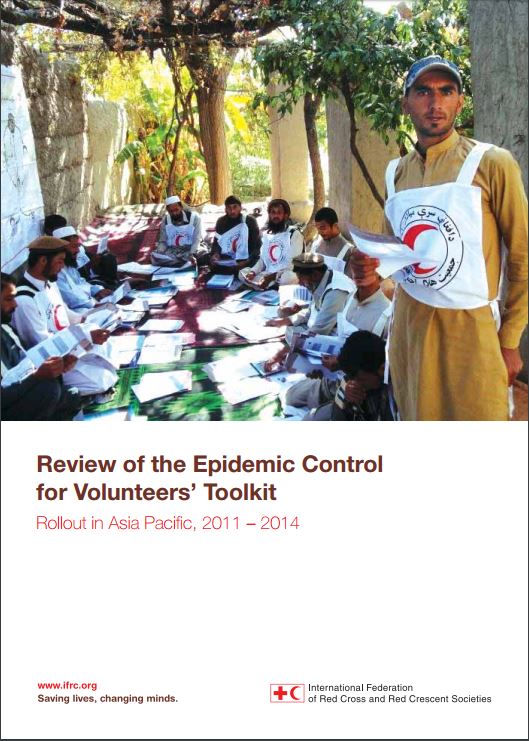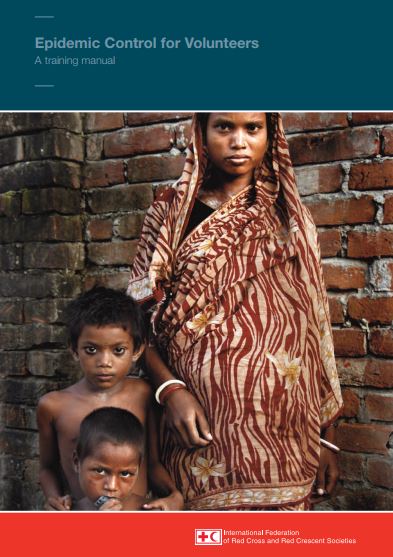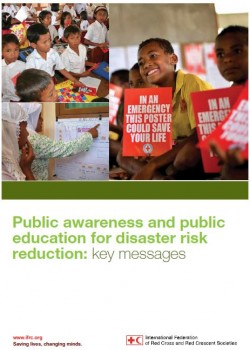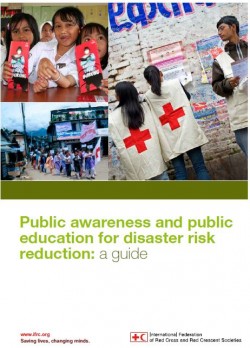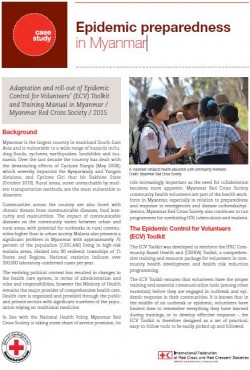Review of the Epidemic Control for Volunteers’ Toolkit – Rollout in Asia Pacific, 2011 – 2014
Purpose
This document provides a review of the Epidemic Control for Volunteers (ECV) Manual and Toolkit and its rollout in Asia Pacific. It includes case studies on the use of the toolkit in a number of countries in Asia Pacific.
Overview
- The evaluation found the original English text to be clear and simple to understand, although there was some duplication between sections of sessions 2 and 3, especially in relation to the roles and expectations of volunteers. Graphics and drawings required contextualisation. National Societies were advised to adapt illustrations to their own settings.
- The original ECV toolkit and manual covers 17 of the most common diseases occurring during epidemics. There are some diseases with epidemic potential that are not included in the toolkit. Some National Societies decided to include additional diseases after consultation with their national health authorities. The addition required a significantly higher degree of work compared with those disease pages that required translation and adaptation only. In some cases, the addition of new diseases to the tool delayed the whole production process.
- The rollout of the toolkit was highly relevant and effective in meeting countries’ needs, epidemic priorities and in the contexts of the community programmes. The strategy of sensitising the leadership of National Societies and relevant national authorities as the first step has proven to be highly effective in beginning the rollout of ECV as this helped pave the way for mainstreaming it into National Societies’ health programmes or those of national authorities, as well as emergency contingency planning. The approach of mainstreaming and integration into existing health or disaster management programmes was also widely recognised as appropriate to ensure sustainability and optimal use of resources.
- Recommendations from the evaluation include: keeping it simple; keeping it flexible; the need for National Societies to consider the toolkit as their tool, not an IFRC programme; keeping the training timeframe adaptable; considering additional options – online training, (and, for example, offline CDs); improving advocacy and the dissemination of the materials.
Usage: Learning from experience
Audiences: Technical staff
Citation: International Federation of Red Cross and Red Crescent Societies (2015). Review of the Epidemic Control for Volunteers’ Toolkit. Rollout in Asia Pacific, 2011 – 2014. (pp. 1-72).
See related document: Epidemic Control for Volunteers: A Training Manual
![]()
Epidemic Control for Volunteers: A Training Manual
Purpose
This toolkit is designed to guide actions in response to epidemics. It consists of three major components: disease tools, which describe the diseases that can cause epidemics; action tools which describe actions that need to be taken in epidemics; and community message tools which provide important information for the community.
Overview
Three steps have to be followed to use the toolkit:
- Step 1: Find the card that matches the disease the local health authorities have said is causing the epidemic. Remember what causes the disease, how it is transmitted, what symptoms it causes, how it is prevented and controlled, and what volunteers can do to help.
- Step 2: Find the appropriate action tool by matching its number with that of the disease tool. Identify the vulnerable members of the community, know the source and cause of the epidemic, and rely on these cards for specific actions to help people during the epidemic.
- Step 3: Match the numbers on the front of the chosen action tool with those on the correct community message tool. The tools need to be read carefully to ensure understanding, and then should be shared with other members of the community so that, in any epidemic, everyone knows what to do, and what not to do.
- A list of disease tools with corresponding actions can be found on pp. 78-79.
Usage: Training; Guidance for project implementation
Themes: Response / relief; Community-based or community participation; Health; Information, Public awareness and public education /Education and Communication; Institutional preparedness; Epidemic Control; Communicable disease; Project/programme planning
Audiences: Technical staff; Volunteers
Citation: International Federation of Red Cross and Red Crescent Societies (2008). Epidemic Control for Volunteers: A Training Manual (pp. 1-109).
![]()
Public Awareness and Public Education for Disaster Risk Reduction: Key Messages
Purpose
Harmonised messaging is a key goal in disaster reduction awareness, and is particularly important when it comes to scaling-up efforts to create a culture of safety. To promote consistent actions to the public this document sets out the key messages for public awareness and public education in all-hazard household and family disaster prevention. It then presents hazard-specific advice for drought, earthquakes, floods, pandemics, tropical storms and wildfires.
Overview
Key messages for all-hazard household and family disaster prevention are:
- Find out what could happen and stay informed;
- Make a household disaster and emergency plan, considering everyone in the household;
- Reduce structural, non-structural and environmental risks in and around the home;
- Learn response skills and practise the plan;
- Prepare response provisions to survive for about a week, including evacuation bags;
- Work with family members’ workplaces, schools, neighbours and local community to assess risks, plan to reduce them, and prepare to respond.
Usage: Guidance for project implementation
Audiences: Technical staff; Communication staff
See also: Public Awareness and Public Education for Disaster Risk Reduction: A Guide
Citation: International Federation of Red Cross and Red Crescent Societies (2013). Public Awareness and Public Education for Disaster Risk Reduction: Key Messages (pp. 1-68).
![]()
Public Awareness and Public Education for Disaster Risk Reduction: A Guide
Purpose
This guide is designed to help National Societies to plan and develop public awareness and public education efforts for disaster risk reduction. The guide sets out approaches and tools for public awareness and public education in disaster risk reduction already widely in use by National Societies. It pulls together a range of research on risk communications and public education for behaviour change, and practitioners’ own discoveries in applying these.
Overview
- Key public awareness and public education campaigns approaches are: participatory learning; informal education; and formal school-based interventions. There are three types of tools that can be used to implement these approaches: one-way broadcast (from one single source to a wide audience); two-way face-to-face interactions; and ‘many-to-many’ interactions (as in social networking using telephone and web tools). Evidence shows that using a combination of these types of contact is the best way to support the process of behaviour change.
- The underlying principles on which the strategic framework and the approaches rest are: legitimacy and credibility, consistency, scalability and sustainability. Strategies and ideas under consideration can be measured against these principles during the planning process.
- Four key ingredients for raising awareness effectively are: a well-crafted message; powerful imagery; an engaging and compelling tone; and adapted, localised content.
Usage: Guidance for project implementation; Monitoring and evaluation
Audiences: Technical staff; Communication staff
See also: Public Awareness and Public Education for Disaster Risk Reduction: Key Messages
![]()
Epidemic Preparedness in Myanmar
Purpose
This document is a case study of the adaptation and roll-out of the Epidemic Control for Volunteers’ (ECV) Toolkit and Training Manual in Myanmar.
The roll-out of the ECV Toolkit in Myanmar targeted five communities in Leiwei Township with a population of approximately 11,870 people (2,660 households).
Overview
- First, a coordination and sensitization meeting on epidemic prevention and control was held. It brought together Myanmar Red Cross Society leadership and management representatives from various departments, Ministry of Health officials and the IFRC country office. In addition to this meeting, two sensitization and contingency-planning workshops, based on potential outbreaks of priority diseases, were conducted for Myanmar Red Cross Society staff and volunteers. The ECV toolkit was translated and adapted for the local context. A three-day training session was held to create a group of Myanmar Red Cross Society ‘master trainers’ who would ensure the ECV toolkit was rolled out within the communities where they worked.
- Overall, the project has supported the Myanmar Red Cross Society to increase community preparedness to seasonal disease outbreaks and epidemics, including potential, emerging, infections in the country. The roll-out of the ECV toolkit improved the capacity of Myanmar Red Cross Society volunteers to deliver good quality services to the community and to guide the immediate action of volunteers in response to any epidemic or its threat.
- Some of the challenges faced include: the need for more time than was originally planned; difficulty recruiting project staff due to a lack of experienced applicants; translation and adaption of ECV toolkits taking more time than expected. A full list can be found on pp. 4-5.
Usage: Learning from experience
Audiences: Technical staff
Citation: Myanmar Red Cross Society (2015). Epidemic Preparedness in Myanmar (pp. 1-6).
![]()


